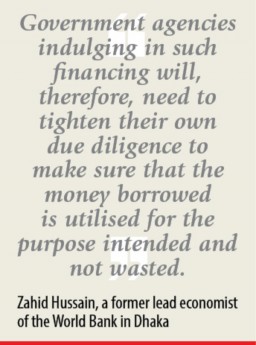Govt redefines hard term external loans

The government has decided to consider foreign loans as hard-term ones if the grant element is less than 25 percent, down from the 35 percent it currently takes into account, in a reflection of the country’s growing economic power.
The revision, which saw a cut of the upper ceiling by 10 percentage points, came at the behest of World Bank and other development and bilateral lenders, according to Finance Minister AHM Mustafa Kamal and a government document.
The minister said Bangladesh used to look at the grant element before taking any concessional loan and it was 35 percent.
“Now, the amount is being brought down to 25 percent,” he told reporters after the weekly meeting of the cabinet committee on economic affairs at the secretariat.
The cabinet committee approved the revision put forward by Economic Relations Division on behalf of the standing committee on non-concessional loans.
As Bangladesh has graduated from a lower income country category, various multilateral and bilateral lenders have raised the interest rate for loans given to the country, according to the proposal of the standing committee.
As a result, the loans are becoming non-concessional and permissions are needed from the standing committee. This may create the uncertainty that flow of foreign loans might slow down.
The Organisation for Economic Co-operation and Development also considers a loan as non-concessional one if the grant element is less than 25 percent, the proposal said.
Talking about the necessity of bringing down the threshold, Kamal said, “This has been done because our economic condition has improved. We were a least developed country. Now we have reached a new height.”
“As everyone has said that the condition of Bangladesh is good and the country has graduated from one level to the next level, the amount is being brought down to 25 percent from 35 percent.”
Kamal, however, said the change would not affect Bangladesh’s borrowing.
Speaking about the change, Zahid Hussain, a former lead economist of the World Bank in Dhaka, said with the increase in per capita income and the prospect of graduating from the LDC status in 2024, the availability of concessional financing was shrinking.
“The decision to lower the threshold from 35 percent to 25 percent is a recognition of this new normal on the terms of financing being offered to Bangladesh.”
He said the lower threshold means approval of the Standing Committee on Non-Concessional Loans would no longer be needed as long as the grant element of the proposed loan was 25 percent or more.
“Government agencies indulging in such financing will, therefore, need to tighten their own due diligence to make sure that the money borrowed is utilised for the purpose intended and not wasted.”
The economist said the recent proliferation of news on proposed costing in development project proposals such as hugely inflated salaries for cleaners and prices of surgical masks and so on suggests the presence of serious weaknesses in the financial design of projects within government agencies.
“The Bangladesh Bank and the ERD will need to strengthen their surveillance of hard-term external public borrowing to ensure that external debt remains sustainable and the rollover risks are mitigated.”
In fiscal 2017-18, public debt in Bangladesh stood at $91 billion, which is about 34 percent of the GDP, according to International Monetary Fund.
External debt stood at $40 billion in the fiscal year and is predominantly owed to multilateral and bilateral creditors, which account for 62 percent and 23 percent respectively of the outstanding debt.
